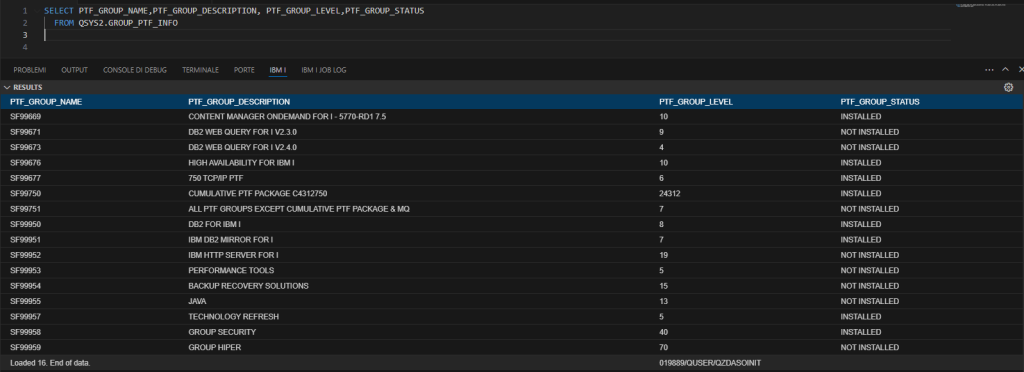In the last post, we have seen how to manage defective PTFs automatically using SQL.Today, we will see how it’s easy to check current PTFs level directly from IBM servers.
Let me say that is quite important to keep systems update, both in terms of version and PTFs. In this way you are able to use all the new features, SQL services and last, but not least, is obtaining all the security-related patches that are needed to cover all the vulnerabilities that come out from day to day.
Let’s check our current PTFs group using GROUP_PTF_INFO view:
SELECT PTF_GROUP_NAME,PTF_GROUP_DESCRIPTION, PTF_GROUP_LEVEL,PTF_GROUP_STATUS
FROM QSYS2.GROUP_PTF_INFO
So, in my example I’ve got some groups in NOT INSTALLED status, it means that the system knows that there are several PTFs that are not installed… In my case is OK, that because I’ve ordered some PTFs using SNDPTFORD.
Now, let’s compare my levels and IBM official levels using GROUP_PTF_CURRENCY, listing only groups that have a difference between current are remote level:
SELECT PTF_GROUP_ID, PTF_GROUP_TITLE, PTF_GROUP_LEVEL_INSTALLED,PTF_GROUP_LEVEL_AVAILABLE
FROM SYSTOOLS.GROUP_PTF_CURRENCY
WHERE PTF_GROUP_LEVEL_INSTALLED<>PTF_GROUP_LEVEL_AVAILABLE 
It’s quite fun, on my system I’m quite updated I need only to install SECURITY and HIPER groups. Let’s consider that these groups are the ones that are updated most frequently.
Now that we have understood all SQL services that we need to use, we will start creating a simple program that will check PTF currency and if there are some new PTFs we will proceed downloading them.

Here is the code to do that: firstly, we will count how many groups on my system are not current. If I found any, I will proceed applying permanently all LIC’s PTFs, that is quite useful when you install cumulative group. After that we will create an IFS path in which we will receive all the ISOs. At the end, we will order all groups PTFs creating an image catalog.
So, this is an idea, you can also choose to order only single groups or you can also choose to download only save files instead of bin-format images.
In this way you can automatically check and download updates for your system. Even in this case you need an internet connection, without this connection you are not able to query IBM servers. Another thing to consider is that before running this program in batch you need to add all contact information (CHGCNTINF command).
Even in this case, this source is available on my GitHub repo.
Let me know what you think about.
Andrea
